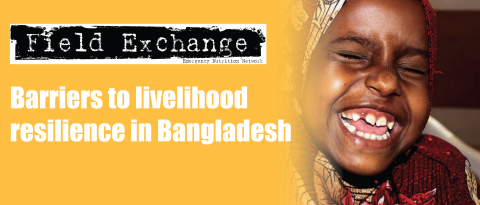Microfinance institutions and a coastal community’s disaster risk reduction, response, and recovery process in Bangladesh
Summary of published research1

A mother and child in Gopalgan, Bangladesh
Location: Bangladesh
What we know already: Microfinance programmes generate income opportunities and contribute to disaster risk reduction.
What this article adds: Current microfinance programmes have limited disaster risk reduction impact around health, income, sanitation, shelter and water supply. Microfinance programme providers (often NGOs) need to develop a more holistic package of services to enhance livelihoods and modify current funding modalities and technical design to address limitations identified by clients.
Microfinance is defined as the delivery of insurance, savings, small loans and other financial services to poor people so that they can generate income opportunities, build an asset base, stabilise consumption and protect themselves against risk. Although microfinance institutions (MFIs) are of different types, non-government organisations (NGOs) are the prime providers of microfinance to the poor in Bangladesh. The government of Bangladesh has recognised coastal zones as areas of enormous potential but lagging behind in terms of socio-economic development and vulnerable to various disasters, environmental degradation and global climate change. Approximately one third of the territory of Bangladesh is defined as coastal with one half of the population poor and vulnerable to manmade and natural disasters, such as arsenic contamination and pollution, coastal flooding, cyclones, erosion, salinity and storm surges.
A recent study has explored the nature of the support provided by MFIs to clients from the most vulnerable coastal communities of Hatiya Island. Approximately 10 MFIs are operating microfinance programmes in the disaster-prone unions (lowest administrative units) of Hatiya. Four of its 10 unions are at particular risk. Consequently these four unions were selected for the study. From these four unions, a total of 110 households (55 from river erosion-affected areas and 55 from cyclone-affected areas) were randomly selected for a household questionnaire survey. However, given that more than half the population of Hatiya island are members of an MFI, this sample size seemed too small. To address this limitation, seven focus group discussions were also conducted with some 20 participants in each. Information on the socioeconomic realities of MFI clients, the nature and the type of MFI support, the contribution of MFI to disaster risk reduction, response, and recovery, and the problems and the expectations related to the MFIs was collected through the questionnaire survey and the focus group discussions.
Results from the study revealed that most MFIs have been operating in Hatiya for more than 15 years. Along with microfinance, MFIs offer different support services to their clients, including the provision of knowledge and information related to education, health, sanitation and social norms, as well as awareness-building and motivation activities pertaining to disaster preparedness, family planning and maternity and child care. The majority of clients believe that the service has facilitated disaster preparedness and recovery. There is a correlation between the number of years of membership of an MFI and the capacity of clients in the area of disaster risk reduction, response and recovery. On the one hand, overall capacity has improved but risk reduction capacity with respect to health, income, sanitation, shelter and water supply has not changed for more than half of the clients. These clients identified several problems with MFIs, such as high interest rates, a strict loan recovery system and no support during a disaster.
Based on the overall findings of this study the authors recommend that along with microfinance, MFIs prioritise disaster risk reduction activities within their regular service delivery apparatus. MFIs themselves are highly vulnerable to natural disasters because they face the problems of dislocation of members, high levels of bad debt, and liquidity crises. Some MFIs have started to adopt mechanisms to reduce the vulnerability of their clients to disasters and to facilitate disaster recovery while safeguarding their own portfolios, but this is still at a rudimentary stage. In reality, most of the NGOs that are prime providers of microfinance rarely incorporate disaster management programmes in their policy strategies.
The authors of the study suggest that MFIs should start to embrace a more holistic and multi-dimensional approach to enhancement of livelihoods, as well as modifying technical design of projects and financing modalities. A more holistic model would incorporate disaster management programmes that place an emphasis on early warning, infrastructure development, micro-insurance and risk reduction, response and recovery considerations. The livelihood diversification programmes of MFIs should focus not only on credit disbursement but also on the generation of skills and incomes that are oriented towards needs and are environmentally sound. Skills development training, the provision of marketing facilities, awareness-building and savings and assets building have to be prioritised. Wide-scale efforts related to knowledge and information dissemination, awareness building and community integration are already part of most MFI programmes but these efforts have to be modified to take account of the present context, especially the threats posed by climate change.
The authors conclude that if this package of services can be made available to MFI clients, it will contribute to the building and diversification of assets, the expansion of coping strategies and a reduction of vulnerabilities. In addition, it could eventually enhance the ability of clients to withstand, to prepare for and to recover from disasters.
1Parvin G and Shaw R (2013). Microfinance institutions and a coastal community’s disaster risk reduction, response, and recovery process: a case study of Hatiya, Bangladesh. Disasters, Volume 37, No 1, pp 165-184. January 2013
Imported from FEX website


